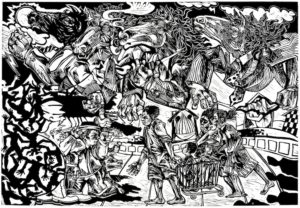When I heard that Professor Lytton Smith was returning to our class to give a second lecture, I was apprehensive. I remember he was the first guest lecturer for our class and that was the day I felt the most lost in class because I was not into the routine of our classes. However, when I walked into class on March 3rd, 2019 I tried to keep an open mind. Smith first began class with the word division and how we define it. To push myself from the first lecture he gave, I participated with my interpretation of division. I discussed how women in New Orleans face division in society by expressing themselves through dancing and music. Mary discussed the division with contrast of dark versus light. Amina thought of a literal divider and a segregated community. Within the span of ten minutes, I knew exactly what I wanted to unpack in my blog post: the word division.
The definition of the word division is extensive. Typing the definition into Google search I discovered numerous usages of it with different subjects such as Logic. But, in general, the noun is defined “as the action of separating something into parts or the process of being separated” or “the distribution of something separated into parts.” However what was interesting was to see how Logic defined it, “as the action of dividing a wider class into two or more subclasses.” These definitions had me thinking about the similarities and differences with the word. For Logic, it specifically mentions classes and subclasses, while the definition of the word as a generic term is to separate a vague “something.” Attempting to unpack this definition is a hard task that I wish to accomplish through the use of Steve Prince’s art and the anthology Walking Raddy: The Baby Dolls of New Orleans.

During class when Smith allowed us time to reflect on the word division in terms of perception or space, I instantly thought about Steve Prince and his style of art. As an artist, I believe Prince encapsulates division in the world, but more centered in America. This brought me back to Prince’s Katrina Suite with the wood block piece “Stand at the Gretna Bridge.” I thought about the division he depicts with the police officers not allowing the civilians in New Orleans to cross the bridge to save themselves from Hurricane Katrina. Instantly while reflecting, I thought of the anthology Walking Raddy: The Baby Dolls of New Orleans. The Baby dolls face division in society with their bodies as females and the pigmentation of their skin being black. In the chapter “Geographies of Pain, Geographies of Pleasure: Black Women in Jim Crow New Orleans” it showed what black women had to face during the Jim Crow years in the South. The lives and bodies of women “were devalued by the Jim Crow system…”. The Jim Crow laws shaped the space and thought process of black women to be able to survive the outside world. The division between black women and the rest of the world was enormous. Therefore, one way black women were able to overcome this division to express themselves and gain their own space again was dancing “at jazz clubs, on street corners, and at Mardi Gras.” They established a new space for “black femininity.” Black women were able to face the division and create their own pathway in society. I am excited and eagerly waiting to hear Vaz-Deville’s lecture on Wednesday, March 13th, 2019. I hope her lecture will give me new sets of tools that I can apply to her anthology and to my future blog posts.
Overall, I believe that at the end of Smith’s lecture I had made huge progress compared to the first one. I remember struggling with his first subject of “lines.” But now, reflecting on the first half of the semester I see tremendous improvement with my thought process in connecting to art and literature. Before, I was unable to naturally connect Prince’s art to a text we were reading in class. Now, during lectures, I can see the connection of text with art during class discussions.
